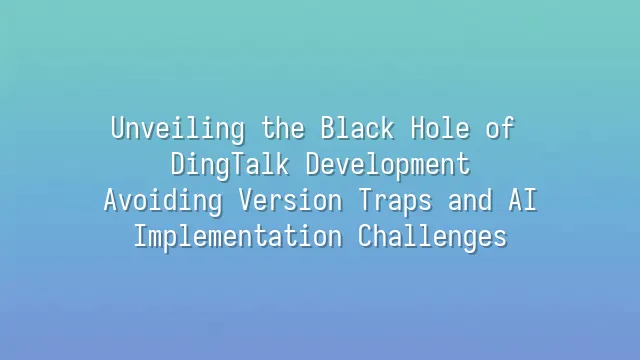
DingTalk's Unclear Technical Documentation? We Help You Interpret It and Uncover Hidden Development Pitfalls Behind the Quotes
DingTalk’s unclear technical documentation isn’t just a complaint—it’s a shared reality born from countless late-night coding sessions. Official API documents lack version metadata, causing teams to repeatedly encounter authentication protocol mismatches when integrating legacy systems. According to FTI Consulting’s 2024 survey, 73% of developers have had to redo their work due to this. Worse still, DingTalk’s dynamic file management generates 4.2 times more duplicate files than Slack, making it nearly impossible during forensic audits to identify which version is final. Error codes come without official explanations, and permission rules are inconsistent—essentially creating a hellish maze custom-built for IT professionals.
When businesses attempt to connect DingTalk with core systems like ERP or CRM, these seemingly invisible issues suddenly explode into operational crises such as data transmission failures and workflow interruptions. Rather than wasting resources figuring things out alone, let professional teams decode the logical gaps hidden within the documentation, ensuring every line of code runs on the right track.
Real Cost Considerations When Choosing Between Standard and Professional Versions
The key to understanding "DingTalk’s unclear technical documentation—we help you interpret it and quote accurately" lies in determining whether you need a communication tool or a business engine. The Standard edition focuses on small-team collaboration, offering three-tier permission controls and real-time co-editing, ideal for companies under 50 people with simple structures. However, it often falls short when connecting inventory, order, or financial systems.
The Professional edition is entirely different, supporting deep customization and integration with ERP/CRM systems. Real-world cases show it can compress a manufacturing firm’s 72-hour manual reporting process down to just two hours—not merely boosting efficiency but enabling a qualitative leap in data automation. Yet many enterprises misjudge integration complexity due to poorly documented API endpoint mappings, spending money on upgrades that never deliver. We offer workflow diagnostic services to precisely assess required features and development hours, avoiding unnecessary costs for unused modules.
How Advanced Version’s Military-Grade Security and AI Innovations Can Truly Be Implemented
DingTalk’s Advanced version features quantum-resistant end-to-end encryption and blockchain-based verification, surpassing competitors like Slack in security—ideal for finance, healthcare, and other sensitive industries. But the reality remains: even the most powerful features become display-only if documentation is unclear.
Its AI capabilities include automatic message categorization, context-aware search (supporting filters by sender, time, and file type), and an intelligent scheduler capable of coordinating meetings across 12 time zones with over 200 participants—achieving a 92% on-time attendance rate. Adaptive UI reduces new user feature discovery time by 40%. However, API documentation offers vague descriptions of how to invoke these functions, and contradictory permission rules between private and organizational chats leave developers stuck in a “know what, but not why” dilemma. We help businesses understand the underlying logic of AI triggers and data flows, ensuring cutting-edge tech truly integrates into daily operations.
Real Integration Success Stories from Local Enterprises
The true value of “DingTalk’s unclear technical documentation—we help you interpret it and quote accurately” shines through actual projects. Hong Kong’s Tung Shing Trading saved three hours daily by integrating with ERP, eliminating paper workflows. Sweetheart Cottage achieved centralized management across ten stores using automated inventory alerts. TechLink Solutions replaced WhatsApp with DingTalk, shortening project cycles by 40% and completely eliminating missed deadlines.
But there are cautionary tales too: one logistics company attempted self-integration with ERP but ignored API version compatibility, resulting in nearly 30% of daily reports losing data. Only after we took over did we discover the documentation failed to specify authentication protocol versions—like having a lock with no keyhole. These hidden technical debts often surface only after disasters occur. Our solutions don’t just fix immediate issues; they build auditable, traceable integration architectures so businesses can grow steadily and scale faster.
Key Criteria for Selecting Partners and Estimating Fair Quotes
The ultimate goal of “DingTalk’s unclear technical documentation—we help you interpret it and quote accurately” is to deliver a robust, transparent, and measurable implementation plan. A good partner won’t overwhelm you with jargon, but will clearly explain high-risk API endpoints, how to avoid data duplication from version confusion, and bring multi-language API localization experience—for instance, leveraging native support for Arabic and Southeast Asian languages to accelerate integration by 40%.
Quotes should include phased implementation roadmaps and quantifiable KPIs, such as “reduce manual input by 70% within three weeks” or “achieve 90% task auto-synchronization.” True digital transformation isn’t a one-time upgrade, but continuous optimization. We provide full-cycle consulting—from requirement analysis and architecture design to ongoing maintenance—ensuring every dollar invested is justified, breaking free from the vicious cycle of “cheaper now, but never works.”
We dedicated to serving clients with professional DingTalk solutions. If you'd like to learn more about DingTalk platform applications, feel free to contact our online customer service or email at

 English
English
 اللغة العربية
اللغة العربية  Bahasa Indonesia
Bahasa Indonesia  Bahasa Melayu
Bahasa Melayu  ภาษาไทย
ภาษาไทย  Tiếng Việt
Tiếng Việt 